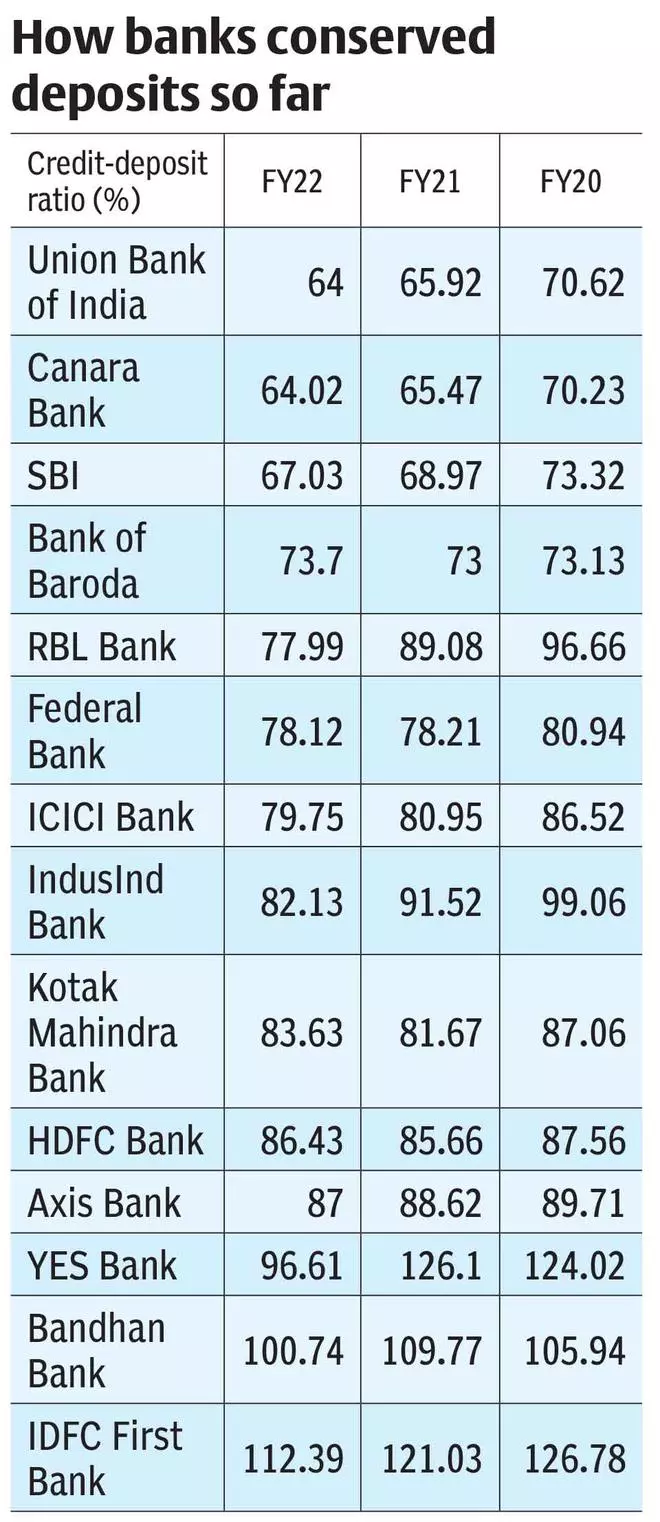The Nifty Bank index touched an all-time high 41,209 points last Wednesday. Buoyant bank credit growth and relatively cleaner balance-sheets of banks are driving the index. But this shouldn’t suggest that banks have found their sweet spot, yet.
They are faced with an issue that they haven’t encountered in several decades — of strong credit demand but tepid deposits accretion.
Latest data published by the RBI indicates that demand for bank loans is at a nine-year high. At ₹5.66 trillion loans extended year-to-date by banks, credit growth is up by 4.8 per cent year-on-year in this period as against a contraction of -0.5 per cent during the corresponding previous period.
Growth in deposits was 9.5 per cent year-on-year for the week ended August 26, 2022. This is well below the last three’s average of around 13 per cent. The combination of the fast-melting liquidity in the system and depositors holding back may limit the ability of banks to grow their loans aggressively.
But here’s some good news. Deposit rates may be headed for the 2018 levels of 7.25-8.5 per cent for 3-year tenure. Currently, they hover at 5.5–6.25 per cent. In short, if banks increase their lending rates in tandem with the repo rate hikes, deposit rates should also catch up quickly in the cycle.
In a recent interview with BusinessLine, Axis Bank’s MD and CEO suggested that with the excess liquidity in the system likely to be drained out in the coming months, deposits will once again account for a chunk of the liquidity mobilisation process.
The repricing has already gathered momentum. Until early August, increase in deposit rates was quite low at 30–60 basis point, while the repo rate has already climbed from 4 per cent to 5.4 per cent, up 140 bps. But in the recent weeks, YES Bank, Axis Bank, Bank of Baroda, ICICI Bank and Union Bank of India raising the fixed deposit rates by 30–50 basis point, the lag between the repo rate hike and the deposit rate hike is gradually reducing. From about 80-100 basis point in July, it has narrowed to 60- 80 bps.
Yet, a strong deposit momentum accretion could still be 6-9 months away.

Shying depositors
Shanti Ekambaram, Group President and Director, Kotak Mahindra Bank, says that today, depending on the investors risk appetite, there are various investment options and deposits aren’t the only one any more. With India surpassing the 10-crore mark of demat accounts recently, and systematic investment plans (SIPs) offered by mutual funds emerging a popular investment product, bankers say SIPs may give a stiff competition to deposits, especially in the retail side.
Moreover, bankers feel depositors may also be on the sidelines to see if banks fully pass on the hikes , before they take the plunge. For now, banks are modelling another 75 bps hike in repo by March 2023 post which they expect some cooling off in hikes. “From January, we should see faster deposit growth,” said a private banker who didn’t want to be named.
Impact on banks
Most private banks, barring Axis Bank and YES Bank, are operating at net interest margin (NIM, a measure of profitability) of over four per cent. With demand remaining robust, banks believe they are well-placed to fully pass on the repo rate hikes on loan products and this has played out well so far.
The yield on assets has also been stable at 8-10 per cent. In fact, the top 10 banks have been quite conservative in utilising their deposits in the last two years and seem to have exploited the excess systemic liquidity to grow their loan books (see table). With that factor draining out and deposit rates set to increase, profitability may get knocked a bit. For now, banks are gearing up for a 5-15 bps fall in the NIM.





Comments
Comments have to be in English, and in full sentences. They cannot be abusive or personal. Please abide by our community guidelines for posting your comments.
We have migrated to a new commenting platform. If you are already a registered user of TheHindu Businessline and logged in, you may continue to engage with our articles. If you do not have an account please register and login to post comments. Users can access their older comments by logging into their accounts on Vuukle.